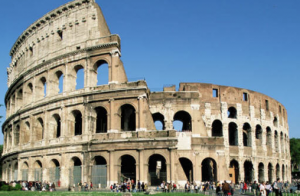Experience what makes Rome the Eternal City: our guided tour of the ancient Rome shows all the most famous places of the city’s rich antique past.

Starting with the Colosseum, also known as the Flavian Amphitheatre you’ll admire the world’s largest and most impressive amphitheatre. In its days of use it could hold up to 80.000 spectators, coming to watch the famous gladiatorial contests. It is surely one of the most spectacular examples of Roman architecture and engineering.
Strolling around the over 2000 years old Roman Forum surrounded by the ruins of several of the most important ancient government buildings will make you truly feel the Roman spirit. For centuries this special field was centre of the Roman public life. It was used as a marketplace, the venue for triumphal processions, elections, public speeches, and criminal trials. The statues and monuments remind of the city’s great men. The Forum is located in a small valley between 2 of the Roman hills: the Palatine Hill and the Capitoline Hill.
Located at the southeast entrance of the Forum on the Via Sacra you’ll see the Arch of Titus, a 1st-century triumphal arch, constructed by the Roman Emperor Domitian to honor his death brother Titian’s brave victories, including the Victory of Jerusalem in 70 AD.
On your way to the Palatine hill you’ll admire the Arch of Constantine another triumphal arch erected by the Roman Senate to commemorate Constantine I’s victory over Maxentius in 312. The arch in situated on the Via Triumphalis, the way victorious emperors took to enter the city on their return. This triumphal route started at the Campus Martius, led through the Circus Maximus, around the Palatine Hill and through the Arch of Constantine. It further led to the Forum Romanum following the Via Sacra and on to the Capitoline Hill, passing also the Arche of Titus.
The Palatine Hill is a remarkable and special place for the city: According to Roman mythology, the cave, where Romulus and Remus were found by their wolf-mother was on the Palatine Hill. On request you can also visit the Palatine Museum (Museo Palatino) where you’ll be able to admire a vast collection of Roman sculptures all found in the area.
Our expert guide is going to provide you with a lot of historic facts and background information, not to forget interesting stories about the habits and traditions of people in the antique Rome.
Book you tour now by clicking here or call us under +39 552670402.
